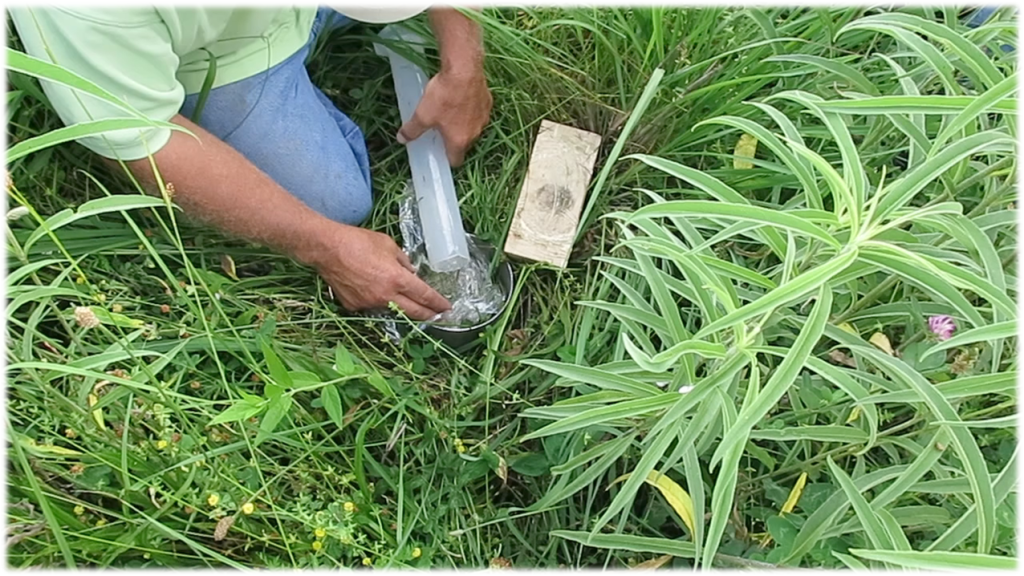
Land that Drinks in the Rain
There are two Ozark hills. Both face north and their rocks and soil are covered with a healthy sward of vegetation which is intermittently grazed by livestock. One hillside is the substrate for a diverse native grassland and the other for fescue. Both are well managed, and we figured that the land in both locations would drink in the rain in similar fashions.
Infiltration is Important
When the land drinks in water, it is used to produce crops, forage, and other vegetation, and it also recharges groundwater supplies. In contrast, rain that makes a sudden dash for the ocean often causes floods, and in its determination to find lower elevations, it causes damage to farmland, roads, and houses. In its haste, it carries with it soil from the land causing a loss of the land’s productivity, and problems arise downstream as a result of the sediment in the streams. So, it is important not only for the land on which the rain falls and the plants growing there that it infiltrates, but it is also important for the neighbor downstream.
Measuring Infiltration on a Diverse Native Grassland
But how are we to know if the rate at which the land drinks in the rain in a diverse native grassland will be the same as in a fescue field without measuring? So in a quest to measure, we set up a simple experiment with the help of Doug Peterson, a Soil Health Specialist with the Natural Resources Conservation Service. We began at the diverse native grassland and drove a metal ring into the soil, measured out an amount of water equivalent to one inch of rain, and dumped it in the ring. One minute and twenty five seconds later, the land had drunk it all in. Again we poured on water. This second inch of rain took longer so while waiting we began to look around at the soil. Doug immediately noticed a large amount of worm castings on the soil surface. He pointed them out noting that the holes earthworms create in the soil could really increase water infiltration. Twelve minutes later, the land had drunk in the second inch of rain. Doug contrasted these infiltration rates to that of a tilled crop field where after an hour of waiting for the land to drink in the first inch of water, they got bored and left.

Measuring Infiltration on an Introduced Grass Pasture
We loaded up the equipment and moved to the other hillside to repeat the tests in the fescue pasture. The first inch of water disappeared in three minutes. It wasn’t quite as fast as the infiltration rate in the diverse native grassland, but three minutes was still a fairly quick infiltration rate. We dumped in the second inch, and while waiting for it to disappear into the soil, we began to look for earthworm castings on the soil surface. They were fewer and further between. Back at the test site, a considerable amount of water remained in the ring. Conversation ensued about the lack of earthworm sign. A big difference in these two hillsides was the vegetation covering them. Doug reminded us that more and more evidence was surfacing that fescue is not conducive to life; not only do the toxins from the endophyte cause problems in livestock, but it apparently causes problems with soil life as well. Still water remained in the ring. Finally, after thirty three minutes, we determined that the land had drunk in the last drop of water. It took almost three times as long as in the diverse native grassland! And while this wasn’t a replicated study, it does give us a solid observation to think about.
Ancient Words of Wisdom
When the writer penned the ancient words, “Land that drinks in the rain often falling on it and that produces a crop useful to those for whom it is farmed receives the blessing of God” (Hebrews 6:7), he understood the importance of water infiltration. Fescue is so widespread across Missouri’s landscape, and pondering all of this makes us imagine what a difference native vegetation could make if it covered a whole watershed. The land would drink in more rain, which would mean more water for the plants to grow and complete their lifecycles. Furthermore, as the water filtered through the soil and into the groundwater supply maybe fishing holes would return to our small creeks and springs that haven’t run in years would run again…
| Diverse Native Grassland | Fescue Field | Crop Field * | |
| First Inch of Rain | 1.42 minutes | 3 minutes | > 60 minutes |
| Second Inch of Rain | 12 minutes | 33 minutes | Even longer |


